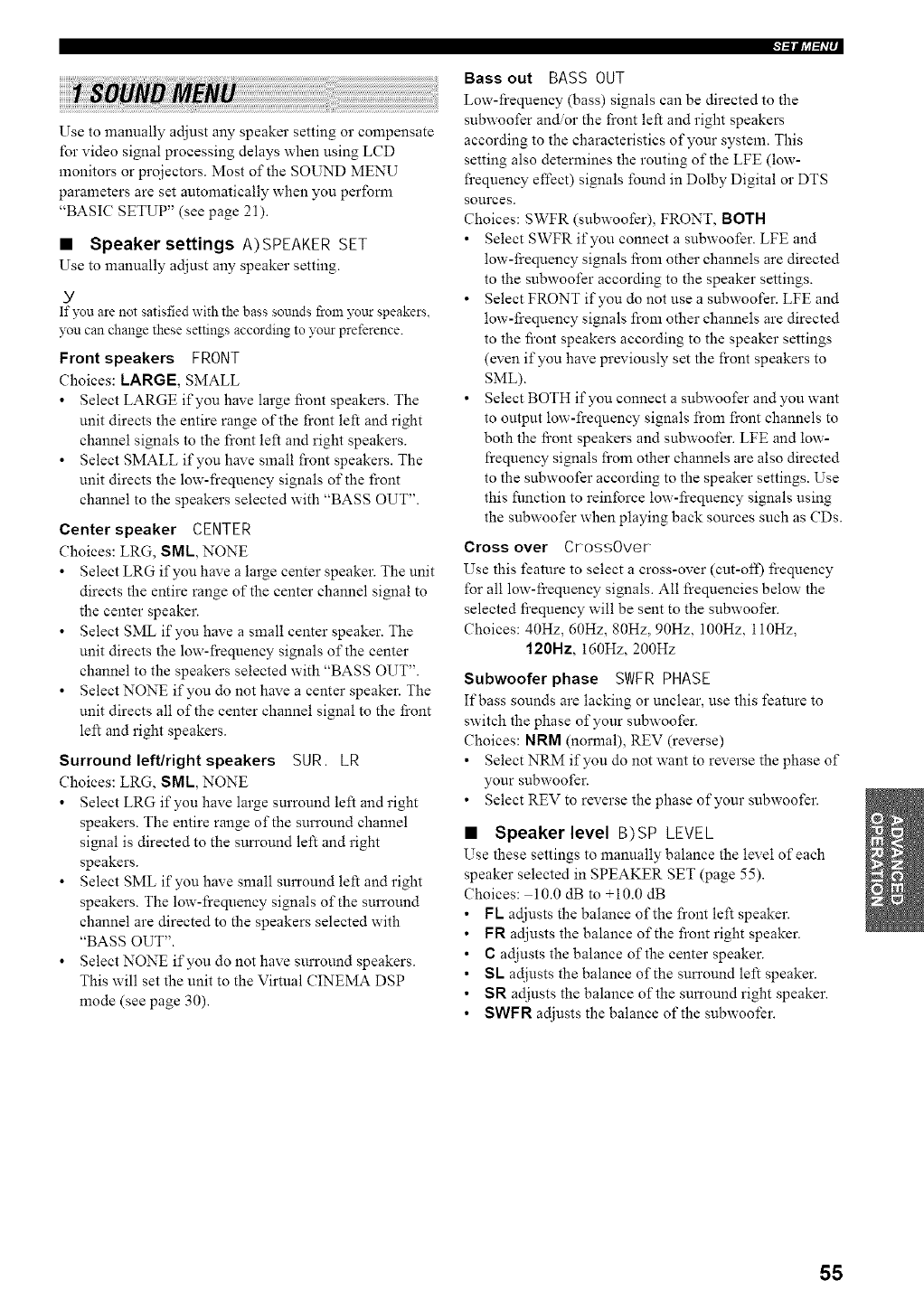
iiii
Use to manually adjust any speaker setting or compensate
for video signal processing delays when using LCD
monitors or projectors. Most of the SOUND MENU
parameters are set automatically when you perform
"BASIC SETUP" (see page 21).
• Speaker settings A)SPEAKER SET
Use to manually adjust any speaker setting.
5/
If you are not satisfied with the bass sounds from yottr speakers,
you can change these settings according to yottr preference.
Front speakers FRONT
Choices: LARGE, SMALL
• Select LARGE if you have large fi'ont speakers. The
unit directs the entire range of the front left and right
channel signals to the fi:ont left and right speakers.
• Select SMALL if you have small front speakers. The
unit directs the low-frequency signals of the front
channel to the speakers selected with "BASS OUT".
Center speaker CENTER
Choices: LRG, SML, NONE
• Select LRG if you have a large center speaker. The unit
directs the entire range of the center channel signal to
the center speaker.
• Select SML if you have a small center speaker. The
unit directs the low-fi:equency signals of the center
channel to the speakers selected with "BASS OUT".
• Select NONE if you do not have a center speaker. The
unit directs all of the center channel signal to the front
left and right speakers.
Surround left/right speakers SUR. LR
Choices: LRG, SML, NONE
• Select LRG if you have large surround left and right
speakers. The entire range of the surround channel
signal is directed to the surround left and right
speakers.
• Select SML if you have small surround left and right
speakers. The low-frequency signals of the surround
channel are directed to the speakers selected with
"BASS OUT".
• Select NONE if you do not have surround speakers.
This will set the unit to the Virtual CINEMA DSP
mode (see page 30).
l=t|_'tl=h'|,
Bass out BASS OUT
Low-frequency (bass) signals can be directed to the
subwoofer and.or the front left and right speakers
according to the characteristics of your system. This
setting also determines the routing of the LFE (low-
frequency effect) signals found in Dolby Digital or DTS
sources.
Choices: SWFR (subwoofer), FRONT, BOTH
• Select SWFR if you connect a subwoofer. LFE and
low-frequency signals fi:om other channels are directed
to the subwoofer according to the speaker settings.
• Select FRONT if you do not use a subwoofer. LFE and
low-frequency signals from other channels are directed
to the fi'ont speakers according to the speaker settings
(even if you have previously set the front speakers to
SML).
• Select BOTH if you connect a subwoofer and you want
to output low-frequency signals fi:om fi'ont channels to
both the fi'ont speakers and subwoofer. LFE and low-
frequency signals from other channels are also directed
to the subwoofer according to the speaker settings. Use
this function to reinforce low-fi'equency signals using
the subwoofer when playing back sources such as CDs.
Cross over CrossOver
Use this feature to select a cross-over (cut-oil) fi:equency
for all low-fi:equency signals. All frequencies below the
selected fi'equency will be sent to the subwoofer.
Choices: 40Hz, 60Hz, 80Hz, 90Hz, 100Hz, 110Hz,
'120Hz, 160Hz, 200Hz
Subwoofer phase SWFR PHASE
If bass sounds are lacking or unclear, use this feature to
switch the phase of your subwoofer.
Choices: NRM (normal), REV (reverse)
• Select NRM if you do not want to reverse the phase of
your subwoofer.
• Select REV to reverse the phase of your subwoofer.
• Speaker level B)SP LEVEL
Use these settings to manually balance the level of each
speaker selected in SPEAKER SET (page 55).
Choices: 10.0 dB to +i0.0 dB
• FL adjusts the balance of the front left speaker.
• FR adjusts the balance of the front right speaker.
• C adjusts the balance of the center speaker.
• SI_ adjusts the balance of the surround left speaker.
• SR adjusts the balance of the surround right speaker.
• SWFR adjusts the balance of the subwoofer.
55


















